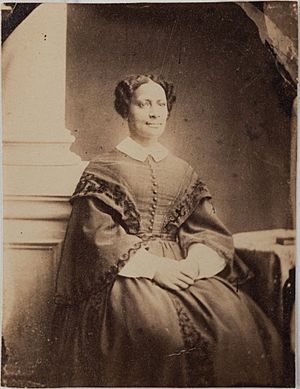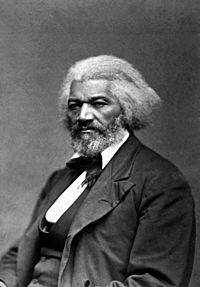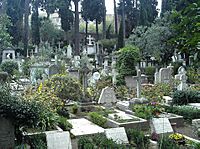Sarah Parker Remond facts for kids
Quick facts for kids
Sarah Parker Remond
|
|
|---|---|
 |
|
| Born | June 6, 1826 Salem, Massachusetts, United States
|
| Died | December 13, 1894 (aged 68) |
| Alma mater | Bedford College Hospital of Santa Maria Nuova |
| Occupation | Activist, physician |
| Spouse(s) | Lazzaro Pintor |
| Parent(s) | John Remond (father) Nancy Lenox (mother) |
| Relatives | Charles Lenox Remond (brother) Caroline Remond Putnam (sister) Cecilia Remond Putnam (sister) Marchita Remond (sister) |
Sarah Parker Remond (June 6, 1826 – December 13, 1894) was an American speaker, activist, and a strong fighter against slavery. She was born free in Massachusetts. Sarah became an international activist for human rights and for women's right to vote.
She gave her first public speech against slavery when she was just 16 years old. She traveled across the northeastern United States, giving speeches to end slavery. Her brother, Charles Lenox Remond, was also a famous speaker, and sometimes they toured together.
Later, Sarah became an agent for the American Anti-Slavery Society. In 1858, she went to Britain to get support for the fight against slavery in the United States. While in London, she also studied at Bedford College. She gave lectures during her school breaks. During the American Civil War, she asked the British public to support the Union and their plan to stop supplies from reaching the Southern states. After the war ended, she helped raise money for the millions of newly freed people in the American South.
In 1867, Sarah moved from England to Italy to study medicine in Florence. She became a doctor and worked in Italy for almost 20 years. She never returned to the United States. She passed away in Rome when she was 68 years old.
Contents
Early Life and Family
Sarah Parker Remond was born in Salem, Massachusetts. She was one of many children of John and Nancy Remond. Her mother, Nancy, was the daughter of a Revolutionary War soldier. Her father, John, came to Massachusetts from Curaçao when he was 10 years old. John and Nancy got married in 1807. In Salem, they built successful businesses in catering, supplies, and hairdressing. They became well-known business owners and activists.
The Remond family faced challenges because of their race. Sarah and her sisters were not allowed to attend some private schools. When they were accepted into a local high school, they were later forced to leave. This was because the school wanted to create a separate school for African-American children. Sarah later said this event was "engraved in her heart."
In 1835, the Remond family moved to Newport, Rhode Island. They hoped to find a place with less racism for their children's education. But schools there also refused to accept black students. So, some important African Americans started a private school where Sarah was educated.
The family returned to Salem in 1841. Sarah continued to learn on her own. She went to concerts and lectures. She read many books, pamphlets, and newspapers. She borrowed them from friends or bought them from her community's anti-slavery society. The Remond family also hosted students at their home, including Charlotte Forten.
Three of Sarah's sisters, Cecilia, Maritchie, and Caroline, owned a popular hair salon in Salem. They also had the biggest wig factory in the state. Her oldest sister, Nancy, married an oyster dealer. Sarah's brothers were Charles Lenox Remond, a famous abolitionist speaker, and John Remond.
Fighting Against Slavery
Salem in the 1840s was a busy place for anti-slavery activities. The whole Remond family was deeply involved in the movement to end slavery. Their home was a safe place for both black and white abolitionists. They hosted many leaders of the movement, like William Lloyd Garrison. They also helped enslaved people who were escaping to freedom in the North.
John Remond was a lifelong member of the Massachusetts Anti-Slavery Society. Sarah's older brother, Charles, was the first black speaker for the American Anti-Slavery Society. He was seen as a top black abolitionist. Nancy Remond, Sarah's mother, helped start the Salem Female Anti-Slavery Society. Nancy taught her daughters how to run a household and also how to fight for freedom. Sarah was an active member of several anti-slavery groups. She regularly attended anti-slavery talks in Salem and Boston.
With her family's help, Sarah Remond became a speaker against slavery. She gave her first speech at age 16 in July 1842. She spoke alongside her brother Charles in Groton, Massachusetts. Sarah became well-known among abolitionists in 1853. This happened when she refused to sit in a separate section at a theater. She had bought tickets for herself and friends to see an opera in Boston. When they arrived, she was told to sit in a segregated area. She refused and was forced to leave, even being pushed down some stairs.
Sarah sued the theater for what happened. She won her case and was given $500. The theater also admitted they were wrong. The court ordered the theater to allow everyone to sit together.
In 1856, the American Anti-Slavery Society hired speakers, including Sarah Remond. Her brother Charles and Susan B. Anthony were also part of this group. They toured New York State to talk about anti-slavery issues. For the next two years, Sarah and others spoke in many states. They often faced unfair treatment because of racial discrimination. Even though she was new to speaking, Sarah quickly became very good at it. William Lloyd Garrison praised her "calm, dignified manner." He said her speeches made people think and feel deeply. She became one of the society's most powerful speakers.
Abby Kelley Foster, another famous abolitionist, encouraged Sarah when they toured together in 1857.
Speaking in Great Britain

Sarah Remond was a great speaker and good at raising money. She was asked to bring the American anti-slavery message to Britain. Her brother Charles had done this 10 years earlier. She sailed from Boston to Liverpool on December 28, 1858. She arrived on January 12, 1859.
Her first anti-slavery speech in England was on January 21, 1859. A few days later, she gave another speech called "Slave Life in America." In these talks, she spoke clearly about the cruel treatment of enslaved people in the United States. Her stories shocked many listeners. She also described the unfair treatment faced by free black people in the U.S.
For the next three years, Sarah spoke to large crowds across Britain and Ireland. She visited towns like Warrington, Manchester, London, and Leeds. She raised a lot of money for the anti-slavery cause. Between 1859 and 1861, she gave over 45 lectures. Sarah sometimes appeared with Frederick Douglass, another important abolitionist.
Before she sailed, Sarah expected to face the same unfairness she knew in the U.S. But she found more acceptance in Britain. She wrote, "I have been received here as a sister by white women for the first time in my life." She added, "I have received a sympathy I never was offered before."
People praised her speeches. She spoke out against slavery and racial discrimination. Sarah used ideas like family, womanhood, and marriage to connect with her audience. In her short life story, written in 1861, she said that "prejudice against colour" had always cast a "gigantic shadow" over her life. During her tours, Sarah and other U.S. abolitionists compared American slavery to the hard lives of the working class in Britain. Many working-class people came to her lectures.
When the American Civil War (1861–1865) began, Sarah worked to get British support for the Union's plan to stop supplies from reaching the Southern states. British factories relied on cotton from the American South. Sarah talked about this in her speeches. In 1862, she asked her London audience not to let anything stop Britain from supporting "the oppressed negro." After the Civil War ended, Sarah focused on helping the millions of freed people in the United States. She asked for money and clothes for them. She was an active member of the London Emancipation Society. Her lecture "The Freeman or the Emancipated Negro of the Southern States of the United States" was published in 1867.
Education and Later Life
From October 1859 to June 1861, Sarah studied at Bedford College. She studied subjects like French, Latin, English literature, music, history, and public speaking. She continued to give her own lectures during school breaks. During this time, she also visited Rome and Florence in Italy.
Sarah stayed involved in the fight against slavery and for women's rights in Britain. She was a member of the London Emancipation Committee. She also helped start the Ladies' London Emancipation Society in 1863. Sarah is believed to be the only black woman among the 1500 people who signed a petition in 1866 asking for women's right to vote. She briefly returned to the U.S. and joined the American Equal Rights Association. This group worked for equal voting rights for women and African Americans.
Sarah continued her studies at London University College and became a nurse. In 1866, she left England. After visiting Switzerland, she moved permanently to Florence, Italy, in 1867, at age 42. She entered the Santa Maria Nuova Hospital school to study medicine. At that time, it was one of the best medical schools in Europe. Sarah graduated in August 1868.
After becoming a doctor, she stayed in Florence for many years. Later, she lived in Rome. Sarah practiced medicine for over 20 years and never went back to the United States. Her sisters Caroline and Maritcha joined her from the U.S. Frederick Douglass met the three sisters when he visited Rome in 1886.
In Italy, on April 25, 1877, Sarah married Lazzaro Pintor. He was an Italian office worker from Sardinia. By the 1880s, Sarah Remond Pintor had moved to Rome. She passed away on December 13, 1894, in Rome. She is buried at the Protestant Cemetery in Rome.
Honoring Sarah Remond
In 1999, the Massachusetts State House honored six amazing women from the state. They installed marble panels with bronze busts of each woman. Sarah Remond was one of them. Two quotes from each woman are carved on their panel.
The 2019 book New Daughters of Africa includes two writings by Sarah Parker Remond. These are "Why Slavery is Still Rampant" and "The Negro Race in America."
In 2020, University College London renamed its Centre for the Study of Racism & Racialisation. It is now called the "UCL Sarah Parker Remond Centre."
A popular novel in Italian, La linea del colori: Il Grand Tour di Lafanu Brown, combines the stories of African-American sculptor Edmonia Lewis and Sarah Parker Remond.
In 2021, the University of Chester announced plans to move most of its teaching to a new building in Warrington. This building is now named the Sarah Parker Remond Building.
In September 2021, Sarah Remond was honored in Wakefield, West Yorkshire, England. She had spoken there in 1859–1860 about the evils of slavery. After her lecture, the Wakefield Anti-Slavery Association was created in January 1860.
In 2022, a special blue plaque was announced in London to honor her. It was unveiled on March 25.
Images for kids
-
Frederick Douglass, around 1879. Sarah Remond and Douglass spoke together in Britain.
See also
 In Spanish: Sarah Parker Remond para niños
In Spanish: Sarah Parker Remond para niños





